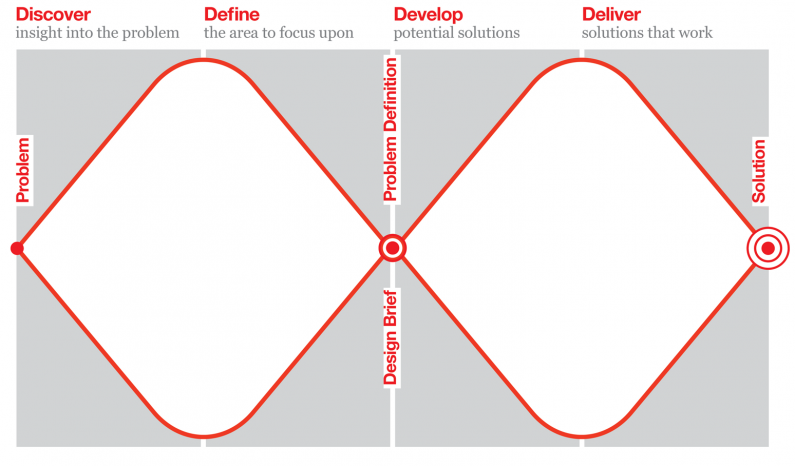Discovery through staff interviews – pinpointing the pain
As part of our user research in the discovery phase we interviewed University staff about their experiences of providing services to prospective students.
Our goal was to uncover insight relating to staff experiences to see how it fits in with other areas of discovery work we’re doing.
As a team our purpose is to deliver effective, efficient and satisfying prospective student website experiences. However, we purposely didn’t limit our questions to website experiences (such as the degree finder or School pages) as we wanted to understand where website activity fits into the broader picture for staff.
Following the Double Diamond
We follow the Double Diamond methodology for designing content. This lays out the design process as two diamonds, with discover and define in the first, and develop and deliver in the second.

The first diamond helps people understand, rather than simply assume, what the problem is. It involves speaking to and spending time with people who are affected by the issues.
Design Council, Double Diamond methodology
In the discovery phase, we go broad. We carry out enough research in order to define what the problem we’re trying to solve is.
This is critical. It keeps us from jumping the gun and firing out solutions to problems we don’t fully understand yet.
The Double Diamond model is the basis for the University’s Student Digital Experience Standards which we follow in our work.
Knowing who to ask and what to ask
We invited staff from a variety of roles, perspectives, Schools and Colleges. Some of our interviewees were on the frontline (managing open days and answering enquiries) and others were behind the scenes (updating degree finder and producing web content).
We then designed a script of open-ended questions to guide us in the interviews. The value of open-ended questions lies in the possibility – through each question we allowed the interviewee to take us wherever they wished.
Prioritize open-ended questions: Some users feel very comfortable in interviews, and will give you thorough and complete answers, even without too much prompt. But in some cases, users will answer only what is being asked.
Patrick Thornton, How to conduct user interviews
The overwhelming feeling during our interviews was that staff were relieved to finally have their voices heard, and for things to change. We left each interview feeling invigorated and with a clearer idea of the problems prospective students and staff were facing.
Sorting through the noise: dissecting user interviews
Once we completed a handful of interviews with staff, we transcribed our recordings using an automated transcription service called Temi.
Read our recent post on our experiences using Temi
We printed out each transcript and read them aloud (some of us more deserving of Golden Globes than others). This process enabled us to hear the interviewees as a collective voice, not always in agreement but with plenty of patterns for us to pick up on.
While hearing the transcripts, we wrote down key quotes and recurring topics on post-it notes, for example:
My main concern is having so many variations of programme content in different places and being seen and updated by different people.
We then placed each note onto a large board and reordered them into categories. Several interviewees voiced a similar concern as the quote above, so we placed them all in a category titled ‘golden copy’.
By the end of the process we had defined nine core categories, including:
- school identity
- golden copy
- central services
- content strategy
We also whittled down the post-it notes in each category by removing the duplicates and summarising longer quotes into new post-it notes.
This is how we began painting the picture of how the University creates experiences for prospective students. From there we could see everything:
- where the patterns occurred
- what the majority of people cared about
- where they conflicted
The power of qualitative data
Qualitative research like our interviews was key for the beginning of the discovery process. It allowed us to dive into the most important part of any research – how real people are affected and why change matters.
We can now use this qualitative data as a springboard for our work. We can narrow in on specific topics, analyse the language being used, explore the processes currently in place and pinpoint exactly where and how change needs to happen.
Help us to discover
We are running regular events in the next few months to showcase our research and encourage staff to engage with the process. We greatly appreciate staff input and actively feed comments, or issues raised, back into our own work.
If you are interested in getting involved, sign up to our mailing list or email us directly at cam-student-content@ed.ac.uk




1 replies to “Discovery through staff interviews – pinpointing the pain”